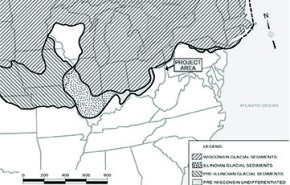Abstract | Buried and sometimes stratified prehistoric sites occur in upland landscapes of the Unglaciated Appalachian Plateau province, although archaeologists have traditionally believed that such settings contain only near surface cultural deposits. The age of colluvial slopes and the characteristics of associated soils vary considerably from north to south within the province, and with the size and order of the valley. We have identified numerous prehistoric sites in low-order valleys in central and southern West Virginia, where the dominant valley fill is a variant of colluvium and alluvium (co-alluvium) that is poorly to moderately sorted and usually stratified. Weakly developed buried soils containing archaeological materials often develop in these strata, and provide evidence of relatively short periods of landscape stability. The archaeological potential of colluvial settings is determined by both the attractiveness of a locale for settlement and by the prospects for preservation of the archaeological remains. In some cases, prehistoric components have been partially disturbed by co-alluvial reworking and redeposition, but, in other cases, the archaeological remains are preserved in a relatively undisturbed context. © 2003Wiley Periodicals, Inc.
April 14, 2003


